Strategic HRM and Balanced Scorecard Analysis: Unilever Report
VerifiedAdded on 2022/11/13
|21
|4974
|425
Report
AI Summary
This report provides a comprehensive analysis of strategic human resource management (SHRM) within the context of the Unilever Group, a multinational consumer goods company. The report begins with an executive summary highlighting the importance of SHRM in driving high performance, employee empowerment, and the role of uniform organizational practices. It examines Unilever's business type, organizational structure, financial performance, products, markets, and competitors. The core of the report focuses on demonstrating the value of SHRM using a balanced scorecard approach, illustrating the connection between HR practices, policies, and business outcomes. It explores key SHRM areas such as motivation and leadership, talent acquisition and retention, employee engagement and training, decision-making and implementation, and competitive advantage. The report provides a detailed overview of Unilever's financial strength, brand value, and global market presence, highlighting the importance of diversity management and employee-centric policies. It also includes a discussion of the company's codes of conduct and their impact on SHRM implementation. The report concludes with recommendations for enhancing employee training frequency and expanding training programs to less strategically important markets, like Africa.
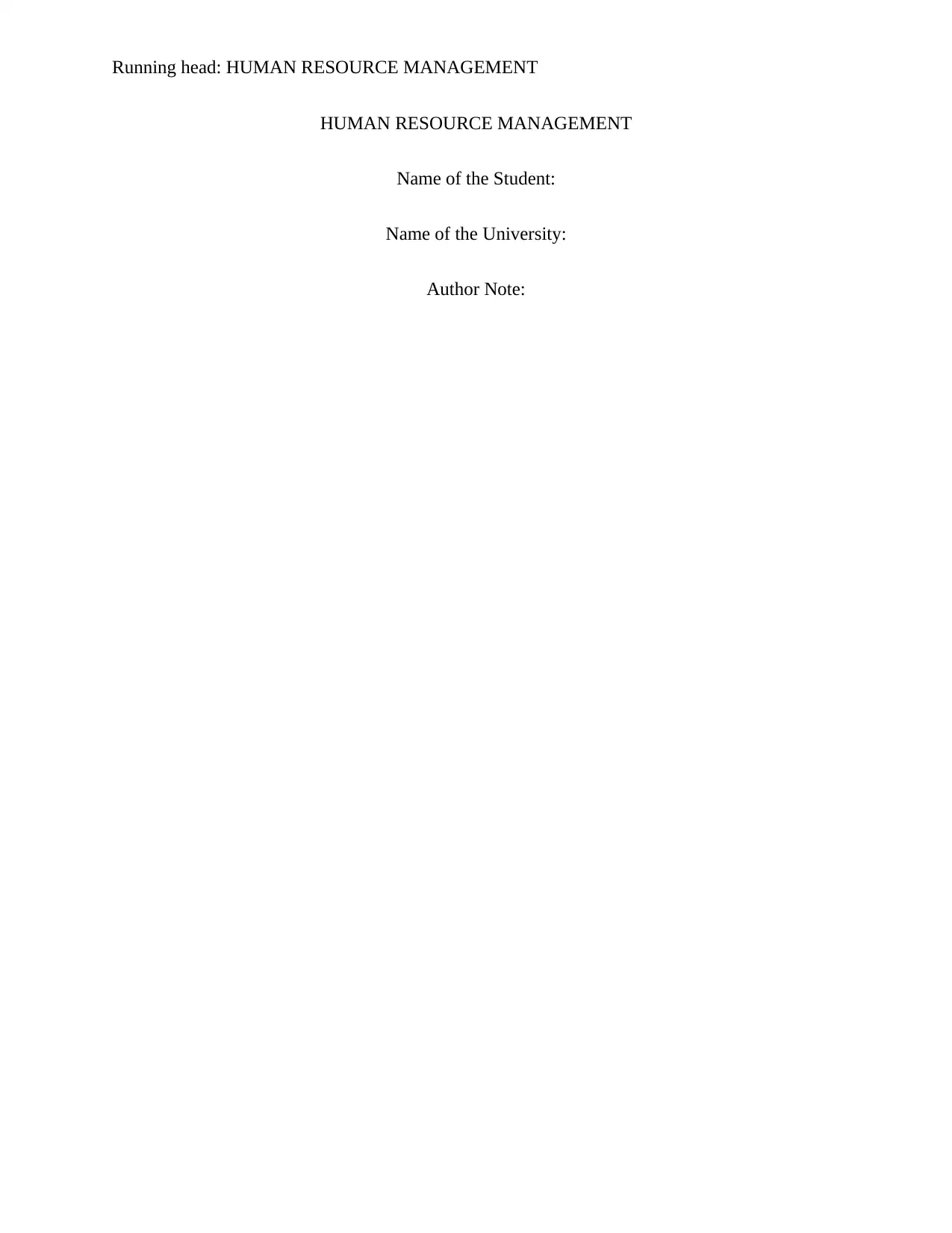
Running head: HUMAN RESOURCE MANAGEMENT
HUMAN RESOURCE MANAGEMENT
Name of the Student:
Name of the University:
Author Note:
HUMAN RESOURCE MANAGEMENT
Name of the Student:
Name of the University:
Author Note:
Paraphrase This Document
Need a fresh take? Get an instant paraphrase of this document with our AI Paraphraser
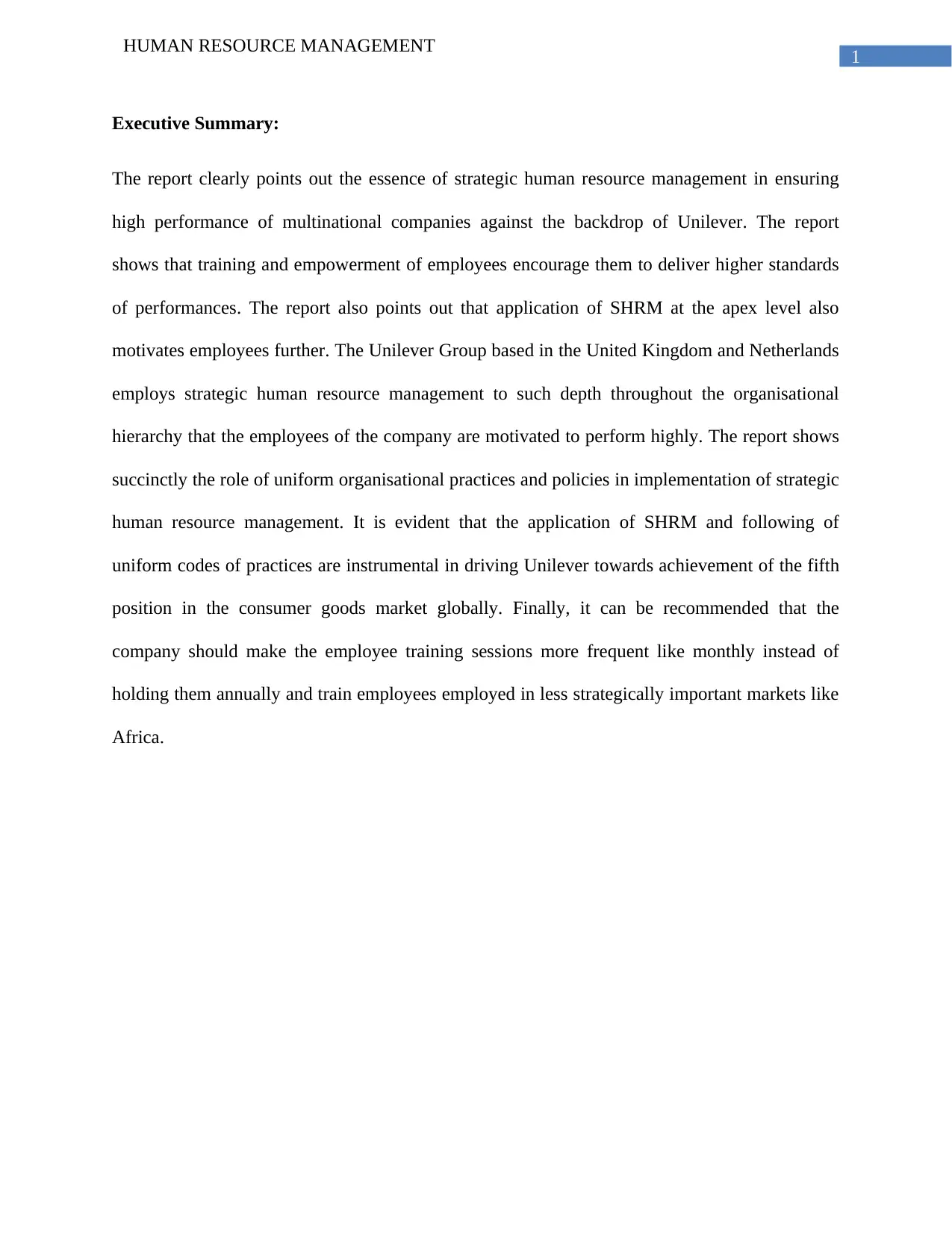
1
HUMAN RESOURCE MANAGEMENT
Executive Summary:
The report clearly points out the essence of strategic human resource management in ensuring
high performance of multinational companies against the backdrop of Unilever. The report
shows that training and empowerment of employees encourage them to deliver higher standards
of performances. The report also points out that application of SHRM at the apex level also
motivates employees further. The Unilever Group based in the United Kingdom and Netherlands
employs strategic human resource management to such depth throughout the organisational
hierarchy that the employees of the company are motivated to perform highly. The report shows
succinctly the role of uniform organisational practices and policies in implementation of strategic
human resource management. It is evident that the application of SHRM and following of
uniform codes of practices are instrumental in driving Unilever towards achievement of the fifth
position in the consumer goods market globally. Finally, it can be recommended that the
company should make the employee training sessions more frequent like monthly instead of
holding them annually and train employees employed in less strategically important markets like
Africa.
HUMAN RESOURCE MANAGEMENT
Executive Summary:
The report clearly points out the essence of strategic human resource management in ensuring
high performance of multinational companies against the backdrop of Unilever. The report
shows that training and empowerment of employees encourage them to deliver higher standards
of performances. The report also points out that application of SHRM at the apex level also
motivates employees further. The Unilever Group based in the United Kingdom and Netherlands
employs strategic human resource management to such depth throughout the organisational
hierarchy that the employees of the company are motivated to perform highly. The report shows
succinctly the role of uniform organisational practices and policies in implementation of strategic
human resource management. It is evident that the application of SHRM and following of
uniform codes of practices are instrumental in driving Unilever towards achievement of the fifth
position in the consumer goods market globally. Finally, it can be recommended that the
company should make the employee training sessions more frequent like monthly instead of
holding them annually and train employees employed in less strategically important markets like
Africa.
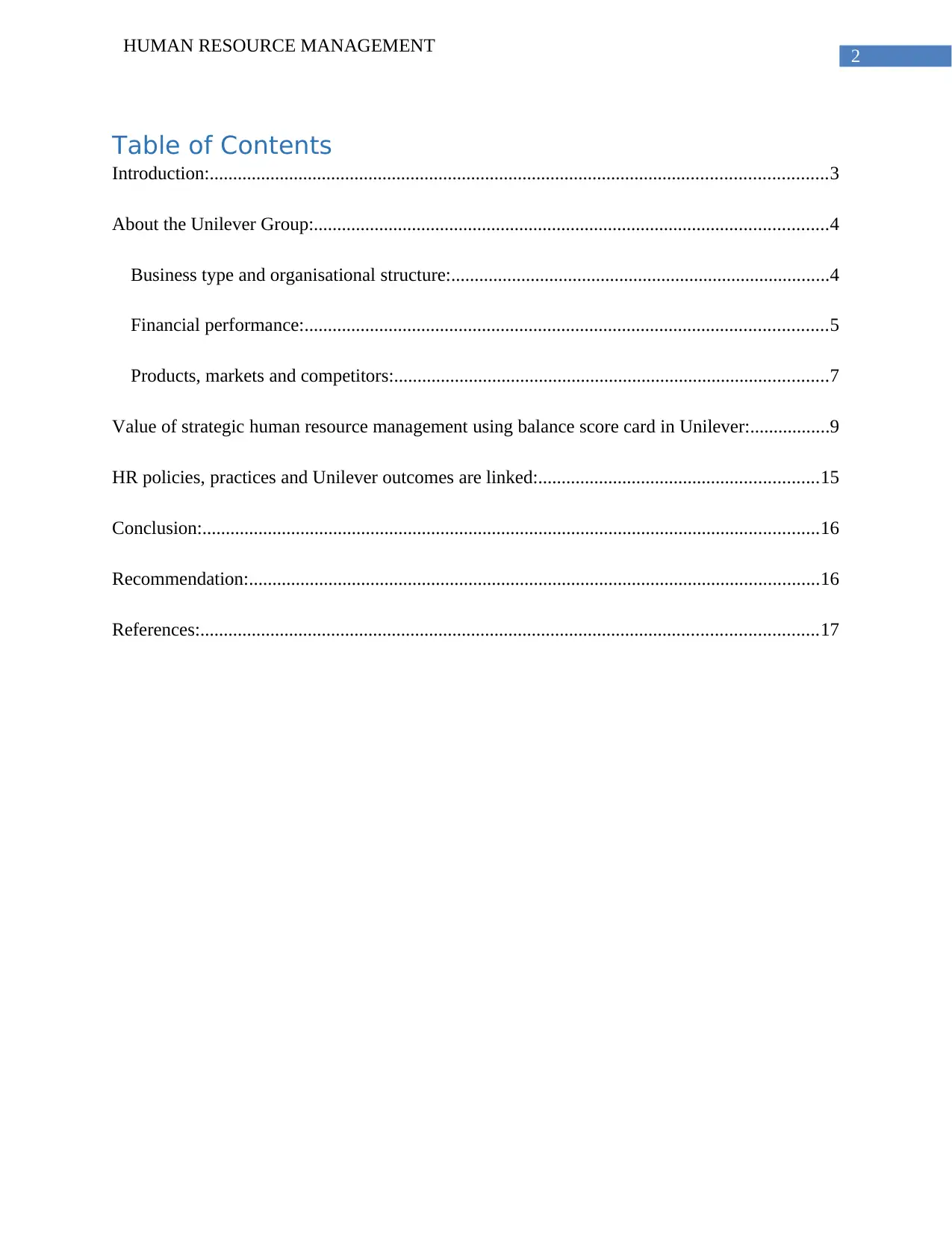
2
HUMAN RESOURCE MANAGEMENT
Table of Contents
Introduction:....................................................................................................................................3
About the Unilever Group:..............................................................................................................4
Business type and organisational structure:.................................................................................4
Financial performance:................................................................................................................5
Products, markets and competitors:.............................................................................................7
Value of strategic human resource management using balance score card in Unilever:.................9
HR policies, practices and Unilever outcomes are linked:............................................................15
Conclusion:....................................................................................................................................16
Recommendation:..........................................................................................................................16
References:....................................................................................................................................17
HUMAN RESOURCE MANAGEMENT
Table of Contents
Introduction:....................................................................................................................................3
About the Unilever Group:..............................................................................................................4
Business type and organisational structure:.................................................................................4
Financial performance:................................................................................................................5
Products, markets and competitors:.............................................................................................7
Value of strategic human resource management using balance score card in Unilever:.................9
HR policies, practices and Unilever outcomes are linked:............................................................15
Conclusion:....................................................................................................................................16
Recommendation:..........................................................................................................................16
References:....................................................................................................................................17
⊘ This is a preview!⊘
Do you want full access?
Subscribe today to unlock all pages.

Trusted by 1+ million students worldwide
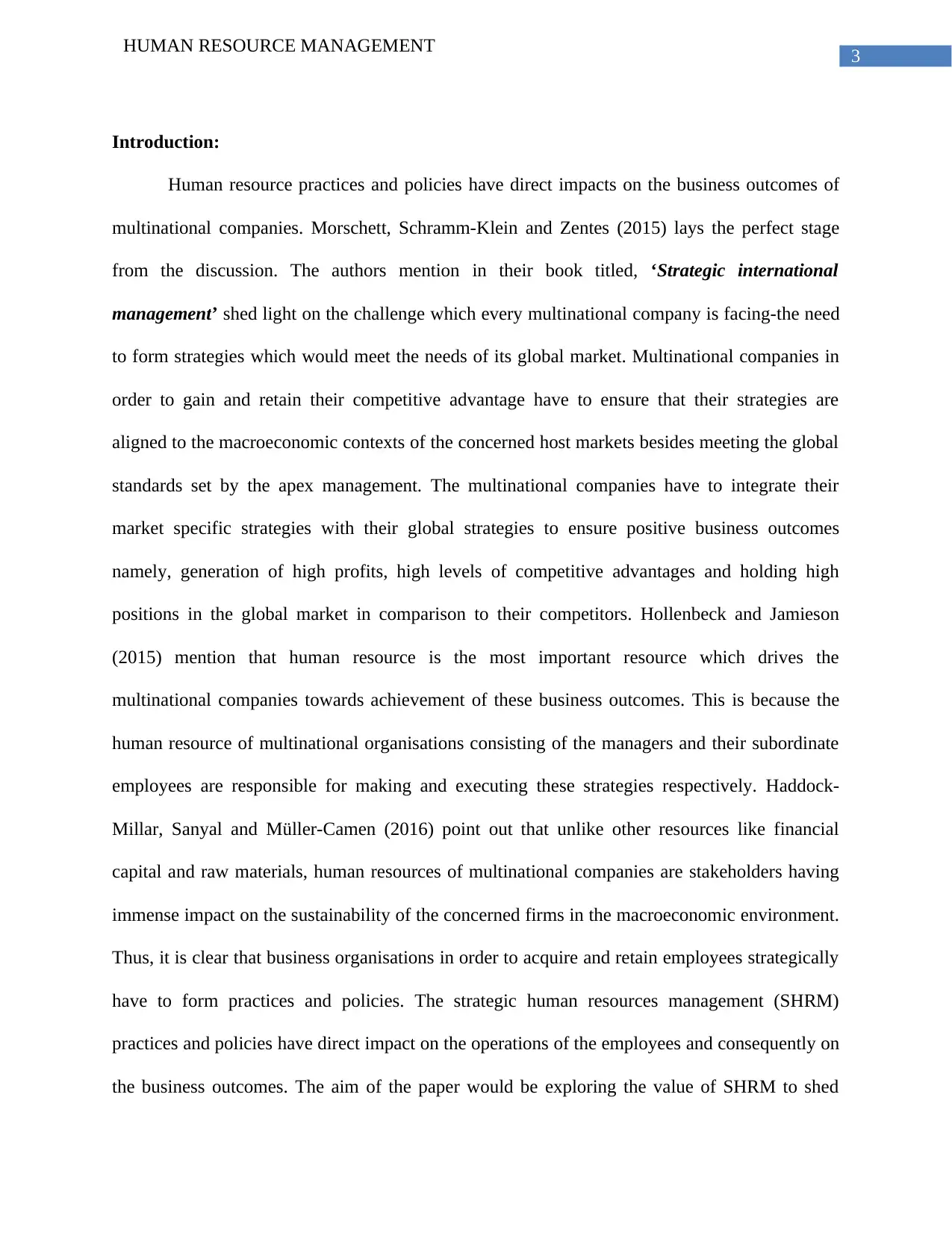
3
HUMAN RESOURCE MANAGEMENT
Introduction:
Human resource practices and policies have direct impacts on the business outcomes of
multinational companies. Morschett, Schramm-Klein and Zentes (2015) lays the perfect stage
from the discussion. The authors mention in their book titled, ‘Strategic international
management’ shed light on the challenge which every multinational company is facing-the need
to form strategies which would meet the needs of its global market. Multinational companies in
order to gain and retain their competitive advantage have to ensure that their strategies are
aligned to the macroeconomic contexts of the concerned host markets besides meeting the global
standards set by the apex management. The multinational companies have to integrate their
market specific strategies with their global strategies to ensure positive business outcomes
namely, generation of high profits, high levels of competitive advantages and holding high
positions in the global market in comparison to their competitors. Hollenbeck and Jamieson
(2015) mention that human resource is the most important resource which drives the
multinational companies towards achievement of these business outcomes. This is because the
human resource of multinational organisations consisting of the managers and their subordinate
employees are responsible for making and executing these strategies respectively. Haddock-
Millar, Sanyal and Müller-Camen (2016) point out that unlike other resources like financial
capital and raw materials, human resources of multinational companies are stakeholders having
immense impact on the sustainability of the concerned firms in the macroeconomic environment.
Thus, it is clear that business organisations in order to acquire and retain employees strategically
have to form practices and policies. The strategic human resources management (SHRM)
practices and policies have direct impact on the operations of the employees and consequently on
the business outcomes. The aim of the paper would be exploring the value of SHRM to shed
HUMAN RESOURCE MANAGEMENT
Introduction:
Human resource practices and policies have direct impacts on the business outcomes of
multinational companies. Morschett, Schramm-Klein and Zentes (2015) lays the perfect stage
from the discussion. The authors mention in their book titled, ‘Strategic international
management’ shed light on the challenge which every multinational company is facing-the need
to form strategies which would meet the needs of its global market. Multinational companies in
order to gain and retain their competitive advantage have to ensure that their strategies are
aligned to the macroeconomic contexts of the concerned host markets besides meeting the global
standards set by the apex management. The multinational companies have to integrate their
market specific strategies with their global strategies to ensure positive business outcomes
namely, generation of high profits, high levels of competitive advantages and holding high
positions in the global market in comparison to their competitors. Hollenbeck and Jamieson
(2015) mention that human resource is the most important resource which drives the
multinational companies towards achievement of these business outcomes. This is because the
human resource of multinational organisations consisting of the managers and their subordinate
employees are responsible for making and executing these strategies respectively. Haddock-
Millar, Sanyal and Müller-Camen (2016) point out that unlike other resources like financial
capital and raw materials, human resources of multinational companies are stakeholders having
immense impact on the sustainability of the concerned firms in the macroeconomic environment.
Thus, it is clear that business organisations in order to acquire and retain employees strategically
have to form practices and policies. The strategic human resources management (SHRM)
practices and policies have direct impact on the operations of the employees and consequently on
the business outcomes. The aim of the paper would be exploring the value of SHRM to shed
Paraphrase This Document
Need a fresh take? Get an instant paraphrase of this document with our AI Paraphraser
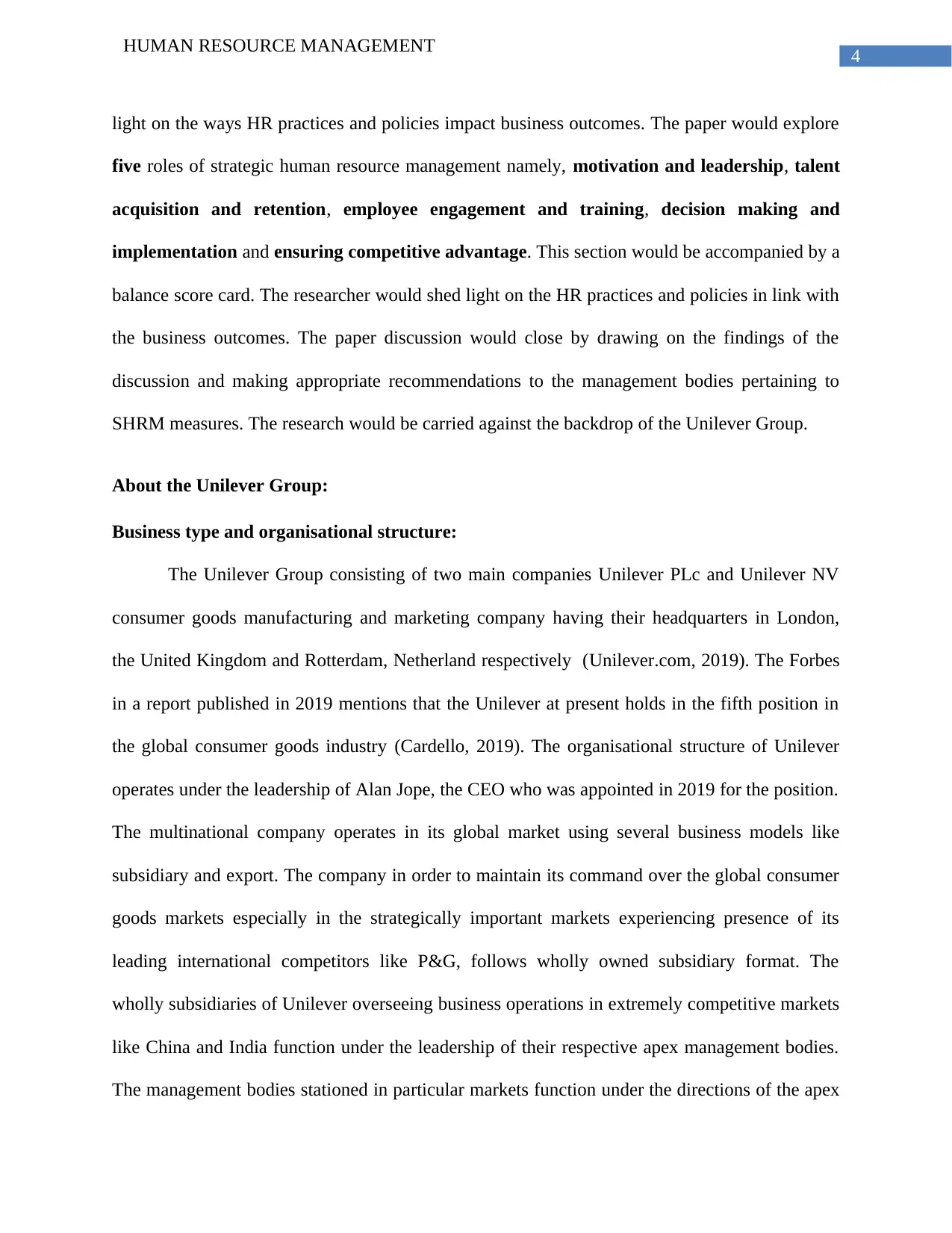
4
HUMAN RESOURCE MANAGEMENT
light on the ways HR practices and policies impact business outcomes. The paper would explore
five roles of strategic human resource management namely, motivation and leadership, talent
acquisition and retention, employee engagement and training, decision making and
implementation and ensuring competitive advantage. This section would be accompanied by a
balance score card. The researcher would shed light on the HR practices and policies in link with
the business outcomes. The paper discussion would close by drawing on the findings of the
discussion and making appropriate recommendations to the management bodies pertaining to
SHRM measures. The research would be carried against the backdrop of the Unilever Group.
About the Unilever Group:
Business type and organisational structure:
The Unilever Group consisting of two main companies Unilever PLc and Unilever NV
consumer goods manufacturing and marketing company having their headquarters in London,
the United Kingdom and Rotterdam, Netherland respectively (Unilever.com, 2019). The Forbes
in a report published in 2019 mentions that the Unilever at present holds in the fifth position in
the global consumer goods industry (Cardello, 2019). The organisational structure of Unilever
operates under the leadership of Alan Jope, the CEO who was appointed in 2019 for the position.
The multinational company operates in its global market using several business models like
subsidiary and export. The company in order to maintain its command over the global consumer
goods markets especially in the strategically important markets experiencing presence of its
leading international competitors like P&G, follows wholly owned subsidiary format. The
wholly subsidiaries of Unilever overseeing business operations in extremely competitive markets
like China and India function under the leadership of their respective apex management bodies.
The management bodies stationed in particular markets function under the directions of the apex
HUMAN RESOURCE MANAGEMENT
light on the ways HR practices and policies impact business outcomes. The paper would explore
five roles of strategic human resource management namely, motivation and leadership, talent
acquisition and retention, employee engagement and training, decision making and
implementation and ensuring competitive advantage. This section would be accompanied by a
balance score card. The researcher would shed light on the HR practices and policies in link with
the business outcomes. The paper discussion would close by drawing on the findings of the
discussion and making appropriate recommendations to the management bodies pertaining to
SHRM measures. The research would be carried against the backdrop of the Unilever Group.
About the Unilever Group:
Business type and organisational structure:
The Unilever Group consisting of two main companies Unilever PLc and Unilever NV
consumer goods manufacturing and marketing company having their headquarters in London,
the United Kingdom and Rotterdam, Netherland respectively (Unilever.com, 2019). The Forbes
in a report published in 2019 mentions that the Unilever at present holds in the fifth position in
the global consumer goods industry (Cardello, 2019). The organisational structure of Unilever
operates under the leadership of Alan Jope, the CEO who was appointed in 2019 for the position.
The multinational company operates in its global market using several business models like
subsidiary and export. The company in order to maintain its command over the global consumer
goods markets especially in the strategically important markets experiencing presence of its
leading international competitors like P&G, follows wholly owned subsidiary format. The
wholly subsidiaries of Unilever overseeing business operations in extremely competitive markets
like China and India function under the leadership of their respective apex management bodies.
The management bodies stationed in particular markets function under the directions of the apex
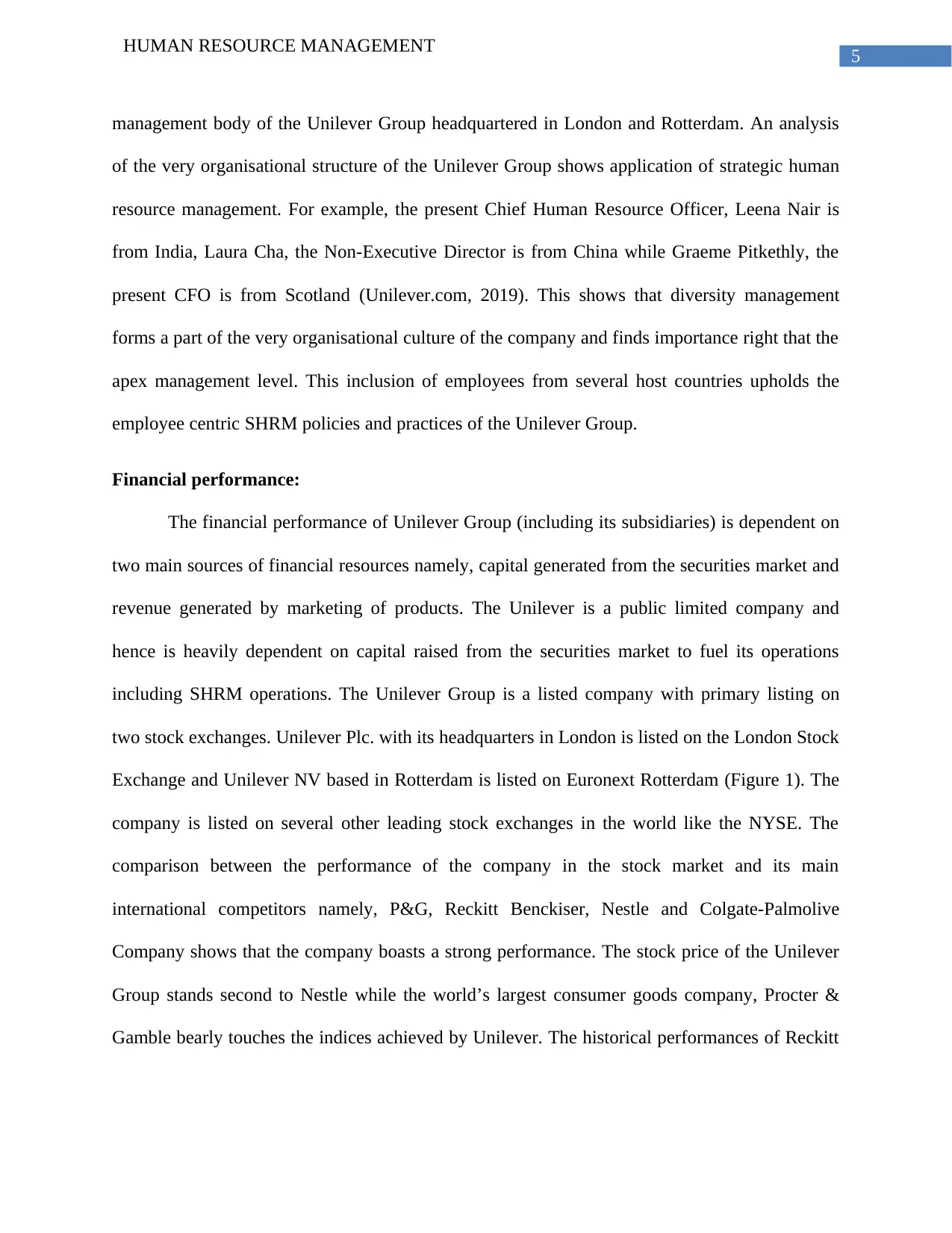
5
HUMAN RESOURCE MANAGEMENT
management body of the Unilever Group headquartered in London and Rotterdam. An analysis
of the very organisational structure of the Unilever Group shows application of strategic human
resource management. For example, the present Chief Human Resource Officer, Leena Nair is
from India, Laura Cha, the Non-Executive Director is from China while Graeme Pitkethly, the
present CFO is from Scotland (Unilever.com, 2019). This shows that diversity management
forms a part of the very organisational culture of the company and finds importance right that the
apex management level. This inclusion of employees from several host countries upholds the
employee centric SHRM policies and practices of the Unilever Group.
Financial performance:
The financial performance of Unilever Group (including its subsidiaries) is dependent on
two main sources of financial resources namely, capital generated from the securities market and
revenue generated by marketing of products. The Unilever is a public limited company and
hence is heavily dependent on capital raised from the securities market to fuel its operations
including SHRM operations. The Unilever Group is a listed company with primary listing on
two stock exchanges. Unilever Plc. with its headquarters in London is listed on the London Stock
Exchange and Unilever NV based in Rotterdam is listed on Euronext Rotterdam (Figure 1). The
company is listed on several other leading stock exchanges in the world like the NYSE. The
comparison between the performance of the company in the stock market and its main
international competitors namely, P&G, Reckitt Benckiser, Nestle and Colgate-Palmolive
Company shows that the company boasts a strong performance. The stock price of the Unilever
Group stands second to Nestle while the world’s largest consumer goods company, Procter &
Gamble bearly touches the indices achieved by Unilever. The historical performances of Reckitt
HUMAN RESOURCE MANAGEMENT
management body of the Unilever Group headquartered in London and Rotterdam. An analysis
of the very organisational structure of the Unilever Group shows application of strategic human
resource management. For example, the present Chief Human Resource Officer, Leena Nair is
from India, Laura Cha, the Non-Executive Director is from China while Graeme Pitkethly, the
present CFO is from Scotland (Unilever.com, 2019). This shows that diversity management
forms a part of the very organisational culture of the company and finds importance right that the
apex management level. This inclusion of employees from several host countries upholds the
employee centric SHRM policies and practices of the Unilever Group.
Financial performance:
The financial performance of Unilever Group (including its subsidiaries) is dependent on
two main sources of financial resources namely, capital generated from the securities market and
revenue generated by marketing of products. The Unilever is a public limited company and
hence is heavily dependent on capital raised from the securities market to fuel its operations
including SHRM operations. The Unilever Group is a listed company with primary listing on
two stock exchanges. Unilever Plc. with its headquarters in London is listed on the London Stock
Exchange and Unilever NV based in Rotterdam is listed on Euronext Rotterdam (Figure 1). The
company is listed on several other leading stock exchanges in the world like the NYSE. The
comparison between the performance of the company in the stock market and its main
international competitors namely, P&G, Reckitt Benckiser, Nestle and Colgate-Palmolive
Company shows that the company boasts a strong performance. The stock price of the Unilever
Group stands second to Nestle while the world’s largest consumer goods company, Procter &
Gamble bearly touches the indices achieved by Unilever. The historical performances of Reckitt
⊘ This is a preview!⊘
Do you want full access?
Subscribe today to unlock all pages.

Trusted by 1+ million students worldwide
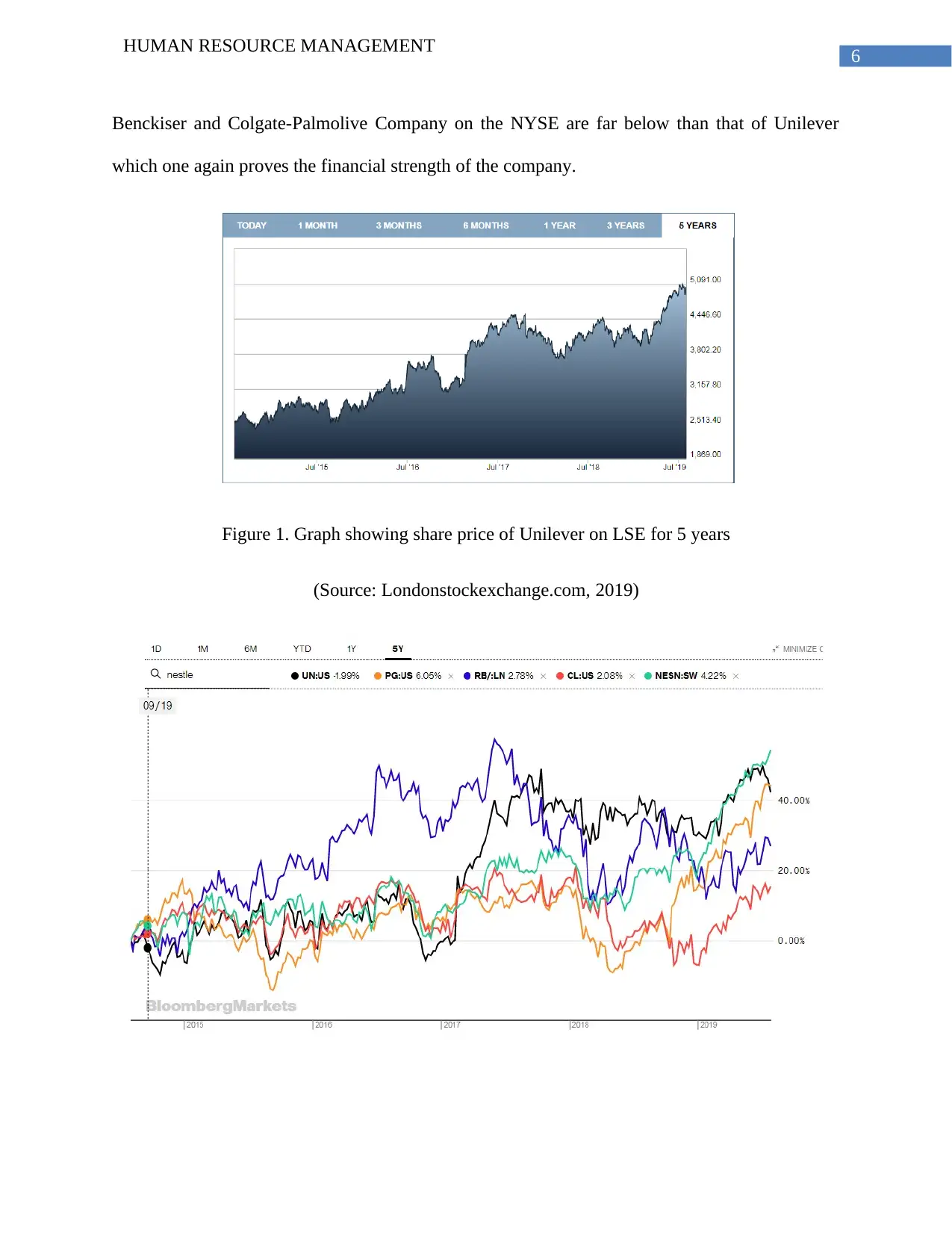
6
HUMAN RESOURCE MANAGEMENT
Benckiser and Colgate-Palmolive Company on the NYSE are far below than that of Unilever
which one again proves the financial strength of the company.
Figure 1. Graph showing share price of Unilever on LSE for 5 years
(Source: Londonstockexchange.com, 2019)
HUMAN RESOURCE MANAGEMENT
Benckiser and Colgate-Palmolive Company on the NYSE are far below than that of Unilever
which one again proves the financial strength of the company.
Figure 1. Graph showing share price of Unilever on LSE for 5 years
(Source: Londonstockexchange.com, 2019)
Paraphrase This Document
Need a fresh take? Get an instant paraphrase of this document with our AI Paraphraser
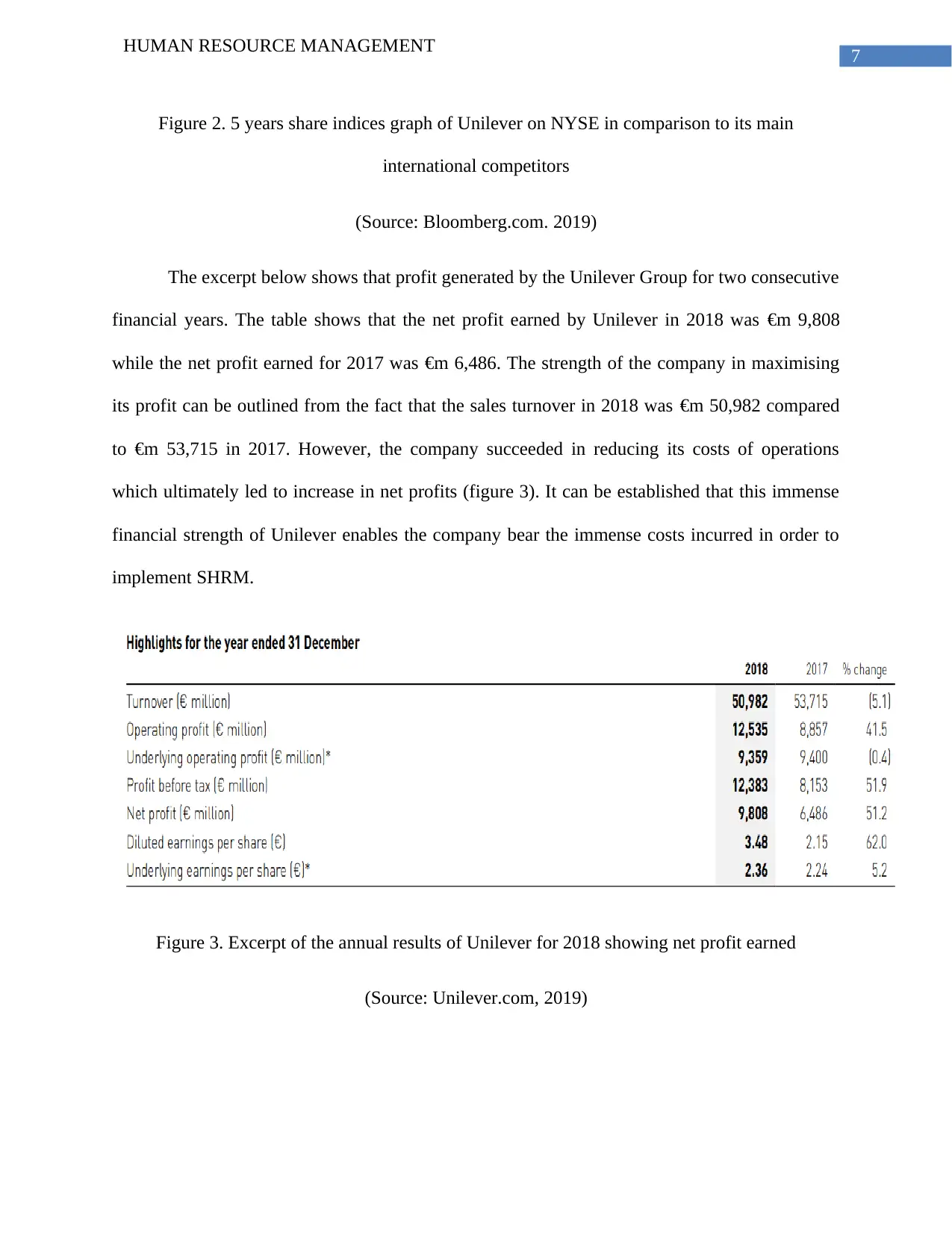
7
HUMAN RESOURCE MANAGEMENT
Figure 2. 5 years share indices graph of Unilever on NYSE in comparison to its main
international competitors
(Source: Bloomberg.com. 2019)
The excerpt below shows that profit generated by the Unilever Group for two consecutive
financial years. The table shows that the net profit earned by Unilever in 2018 was €m 9,808
while the net profit earned for 2017 was €m 6,486. The strength of the company in maximising
its profit can be outlined from the fact that the sales turnover in 2018 was €m 50,982 compared
to €m 53,715 in 2017. However, the company succeeded in reducing its costs of operations
which ultimately led to increase in net profits (figure 3). It can be established that this immense
financial strength of Unilever enables the company bear the immense costs incurred in order to
implement SHRM.
Figure 3. Excerpt of the annual results of Unilever for 2018 showing net profit earned
(Source: Unilever.com, 2019)
HUMAN RESOURCE MANAGEMENT
Figure 2. 5 years share indices graph of Unilever on NYSE in comparison to its main
international competitors
(Source: Bloomberg.com. 2019)
The excerpt below shows that profit generated by the Unilever Group for two consecutive
financial years. The table shows that the net profit earned by Unilever in 2018 was €m 9,808
while the net profit earned for 2017 was €m 6,486. The strength of the company in maximising
its profit can be outlined from the fact that the sales turnover in 2018 was €m 50,982 compared
to €m 53,715 in 2017. However, the company succeeded in reducing its costs of operations
which ultimately led to increase in net profits (figure 3). It can be established that this immense
financial strength of Unilever enables the company bear the immense costs incurred in order to
implement SHRM.
Figure 3. Excerpt of the annual results of Unilever for 2018 showing net profit earned
(Source: Unilever.com, 2019)
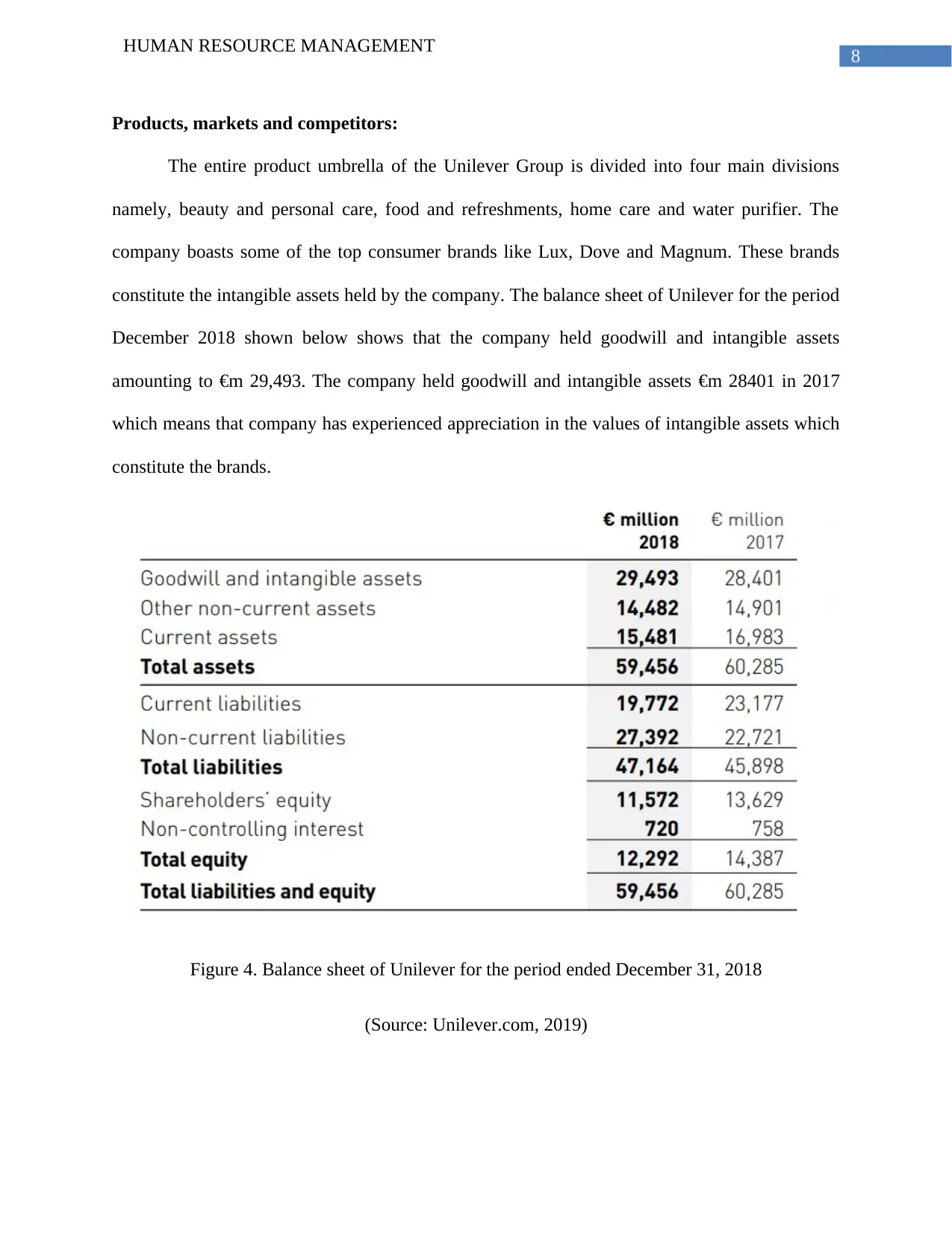
8
HUMAN RESOURCE MANAGEMENT
Products, markets and competitors:
The entire product umbrella of the Unilever Group is divided into four main divisions
namely, beauty and personal care, food and refreshments, home care and water purifier. The
company boasts some of the top consumer brands like Lux, Dove and Magnum. These brands
constitute the intangible assets held by the company. The balance sheet of Unilever for the period
December 2018 shown below shows that the company held goodwill and intangible assets
amounting to €m 29,493. The company held goodwill and intangible assets €m 28401 in 2017
which means that company has experienced appreciation in the values of intangible assets which
constitute the brands.
Figure 4. Balance sheet of Unilever for the period ended December 31, 2018
(Source: Unilever.com, 2019)
HUMAN RESOURCE MANAGEMENT
Products, markets and competitors:
The entire product umbrella of the Unilever Group is divided into four main divisions
namely, beauty and personal care, food and refreshments, home care and water purifier. The
company boasts some of the top consumer brands like Lux, Dove and Magnum. These brands
constitute the intangible assets held by the company. The balance sheet of Unilever for the period
December 2018 shown below shows that the company held goodwill and intangible assets
amounting to €m 29,493. The company held goodwill and intangible assets €m 28401 in 2017
which means that company has experienced appreciation in the values of intangible assets which
constitute the brands.
Figure 4. Balance sheet of Unilever for the period ended December 31, 2018
(Source: Unilever.com, 2019)
⊘ This is a preview!⊘
Do you want full access?
Subscribe today to unlock all pages.

Trusted by 1+ million students worldwide
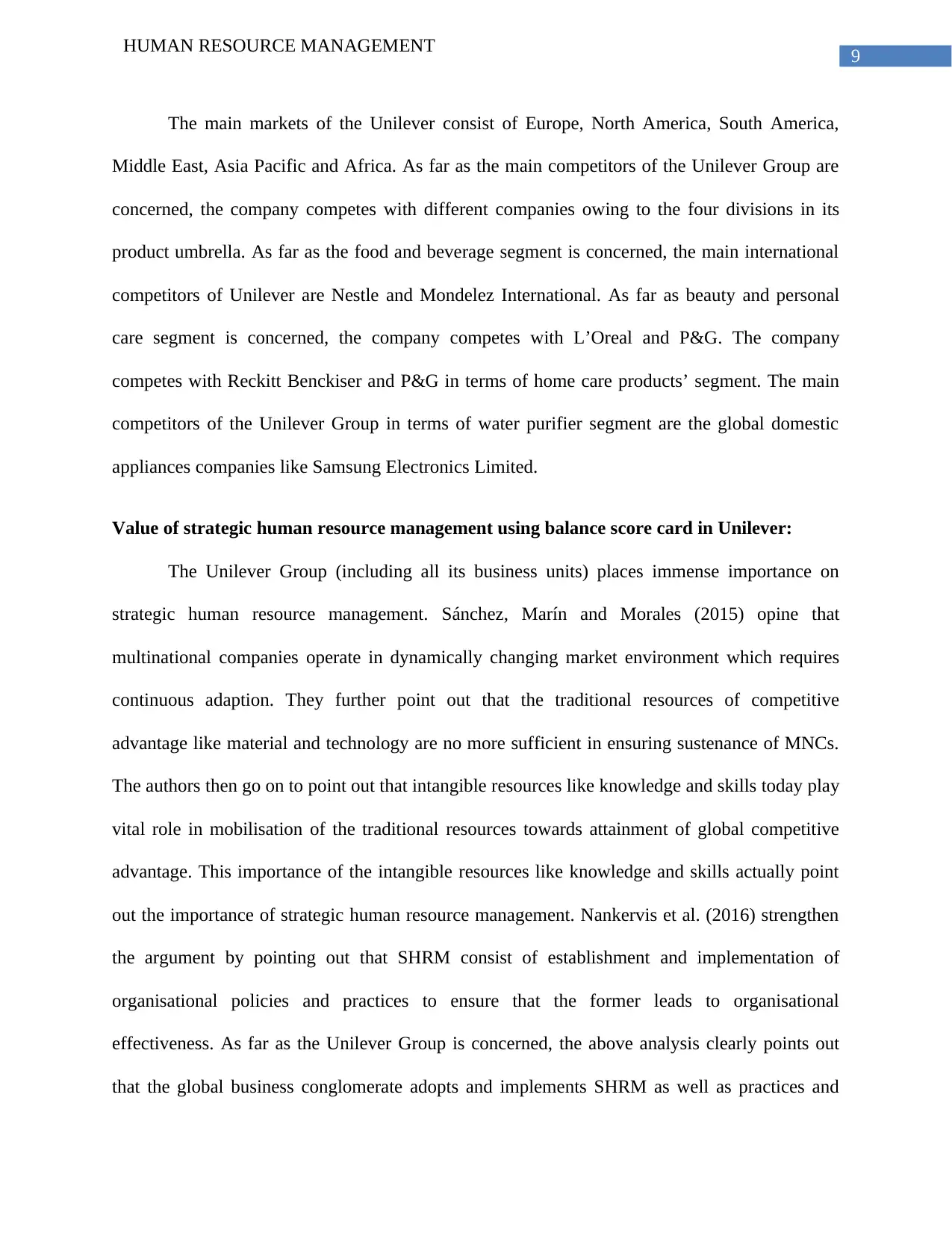
9
HUMAN RESOURCE MANAGEMENT
The main markets of the Unilever consist of Europe, North America, South America,
Middle East, Asia Pacific and Africa. As far as the main competitors of the Unilever Group are
concerned, the company competes with different companies owing to the four divisions in its
product umbrella. As far as the food and beverage segment is concerned, the main international
competitors of Unilever are Nestle and Mondelez International. As far as beauty and personal
care segment is concerned, the company competes with L’Oreal and P&G. The company
competes with Reckitt Benckiser and P&G in terms of home care products’ segment. The main
competitors of the Unilever Group in terms of water purifier segment are the global domestic
appliances companies like Samsung Electronics Limited.
Value of strategic human resource management using balance score card in Unilever:
The Unilever Group (including all its business units) places immense importance on
strategic human resource management. Sánchez, Marín and Morales (2015) opine that
multinational companies operate in dynamically changing market environment which requires
continuous adaption. They further point out that the traditional resources of competitive
advantage like material and technology are no more sufficient in ensuring sustenance of MNCs.
The authors then go on to point out that intangible resources like knowledge and skills today play
vital role in mobilisation of the traditional resources towards attainment of global competitive
advantage. This importance of the intangible resources like knowledge and skills actually point
out the importance of strategic human resource management. Nankervis et al. (2016) strengthen
the argument by pointing out that SHRM consist of establishment and implementation of
organisational policies and practices to ensure that the former leads to organisational
effectiveness. As far as the Unilever Group is concerned, the above analysis clearly points out
that the global business conglomerate adopts and implements SHRM as well as practices and
HUMAN RESOURCE MANAGEMENT
The main markets of the Unilever consist of Europe, North America, South America,
Middle East, Asia Pacific and Africa. As far as the main competitors of the Unilever Group are
concerned, the company competes with different companies owing to the four divisions in its
product umbrella. As far as the food and beverage segment is concerned, the main international
competitors of Unilever are Nestle and Mondelez International. As far as beauty and personal
care segment is concerned, the company competes with L’Oreal and P&G. The company
competes with Reckitt Benckiser and P&G in terms of home care products’ segment. The main
competitors of the Unilever Group in terms of water purifier segment are the global domestic
appliances companies like Samsung Electronics Limited.
Value of strategic human resource management using balance score card in Unilever:
The Unilever Group (including all its business units) places immense importance on
strategic human resource management. Sánchez, Marín and Morales (2015) opine that
multinational companies operate in dynamically changing market environment which requires
continuous adaption. They further point out that the traditional resources of competitive
advantage like material and technology are no more sufficient in ensuring sustenance of MNCs.
The authors then go on to point out that intangible resources like knowledge and skills today play
vital role in mobilisation of the traditional resources towards attainment of global competitive
advantage. This importance of the intangible resources like knowledge and skills actually point
out the importance of strategic human resource management. Nankervis et al. (2016) strengthen
the argument by pointing out that SHRM consist of establishment and implementation of
organisational policies and practices to ensure that the former leads to organisational
effectiveness. As far as the Unilever Group is concerned, the above analysis clearly points out
that the global business conglomerate adopts and implements SHRM as well as practices and
Paraphrase This Document
Need a fresh take? Get an instant paraphrase of this document with our AI Paraphraser
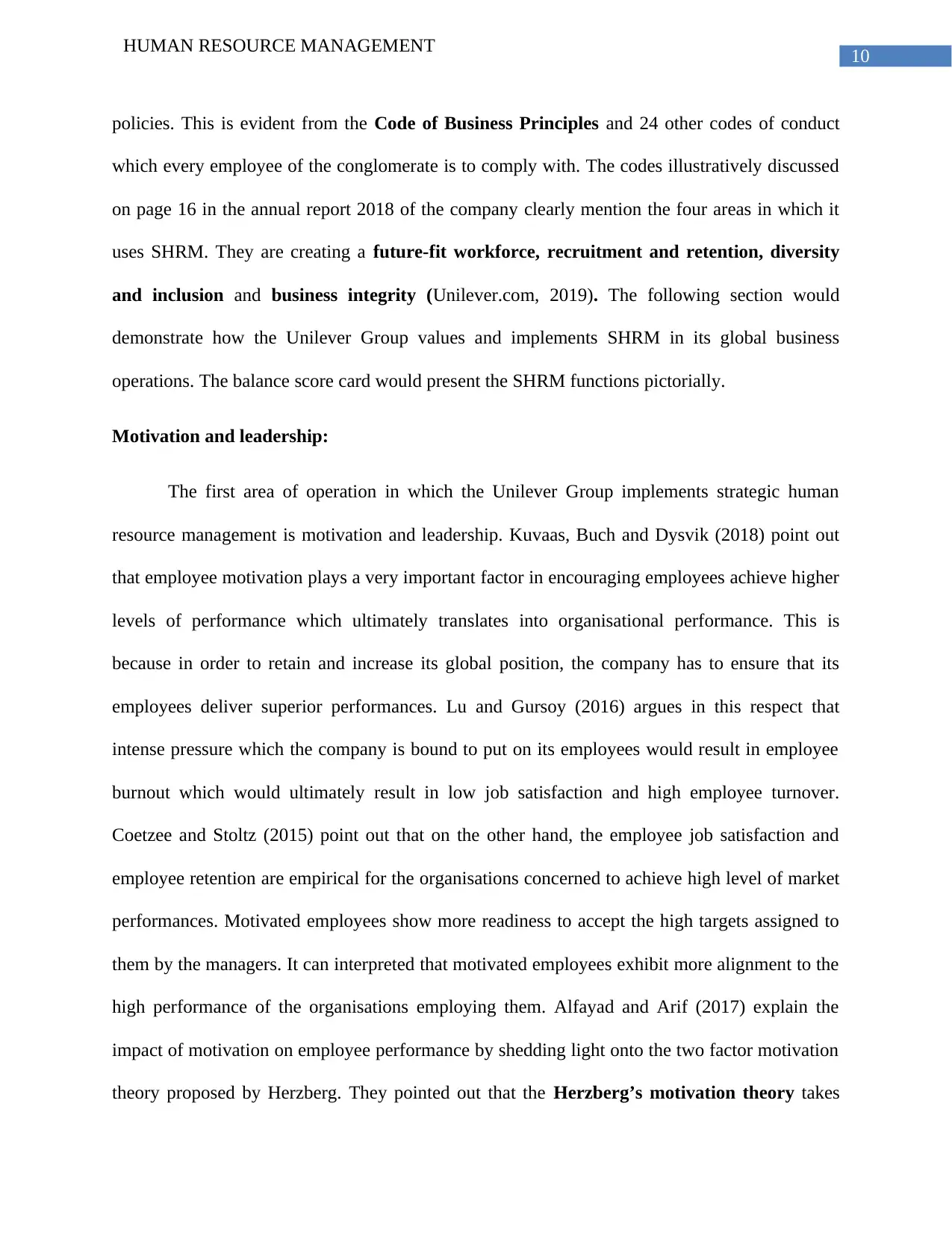
10
HUMAN RESOURCE MANAGEMENT
policies. This is evident from the Code of Business Principles and 24 other codes of conduct
which every employee of the conglomerate is to comply with. The codes illustratively discussed
on page 16 in the annual report 2018 of the company clearly mention the four areas in which it
uses SHRM. They are creating a future-fit workforce, recruitment and retention, diversity
and inclusion and business integrity (Unilever.com, 2019). The following section would
demonstrate how the Unilever Group values and implements SHRM in its global business
operations. The balance score card would present the SHRM functions pictorially.
Motivation and leadership:
The first area of operation in which the Unilever Group implements strategic human
resource management is motivation and leadership. Kuvaas, Buch and Dysvik (2018) point out
that employee motivation plays a very important factor in encouraging employees achieve higher
levels of performance which ultimately translates into organisational performance. This is
because in order to retain and increase its global position, the company has to ensure that its
employees deliver superior performances. Lu and Gursoy (2016) argues in this respect that
intense pressure which the company is bound to put on its employees would result in employee
burnout which would ultimately result in low job satisfaction and high employee turnover.
Coetzee and Stoltz (2015) point out that on the other hand, the employee job satisfaction and
employee retention are empirical for the organisations concerned to achieve high level of market
performances. Motivated employees show more readiness to accept the high targets assigned to
them by the managers. It can interpreted that motivated employees exhibit more alignment to the
high performance of the organisations employing them. Alfayad and Arif (2017) explain the
impact of motivation on employee performance by shedding light onto the two factor motivation
theory proposed by Herzberg. They pointed out that the Herzberg’s motivation theory takes
HUMAN RESOURCE MANAGEMENT
policies. This is evident from the Code of Business Principles and 24 other codes of conduct
which every employee of the conglomerate is to comply with. The codes illustratively discussed
on page 16 in the annual report 2018 of the company clearly mention the four areas in which it
uses SHRM. They are creating a future-fit workforce, recruitment and retention, diversity
and inclusion and business integrity (Unilever.com, 2019). The following section would
demonstrate how the Unilever Group values and implements SHRM in its global business
operations. The balance score card would present the SHRM functions pictorially.
Motivation and leadership:
The first area of operation in which the Unilever Group implements strategic human
resource management is motivation and leadership. Kuvaas, Buch and Dysvik (2018) point out
that employee motivation plays a very important factor in encouraging employees achieve higher
levels of performance which ultimately translates into organisational performance. This is
because in order to retain and increase its global position, the company has to ensure that its
employees deliver superior performances. Lu and Gursoy (2016) argues in this respect that
intense pressure which the company is bound to put on its employees would result in employee
burnout which would ultimately result in low job satisfaction and high employee turnover.
Coetzee and Stoltz (2015) point out that on the other hand, the employee job satisfaction and
employee retention are empirical for the organisations concerned to achieve high level of market
performances. Motivated employees show more readiness to accept the high targets assigned to
them by the managers. It can interpreted that motivated employees exhibit more alignment to the
high performance of the organisations employing them. Alfayad and Arif (2017) explain the
impact of motivation on employee performance by shedding light onto the two factor motivation
theory proposed by Herzberg. They pointed out that the Herzberg’s motivation theory takes
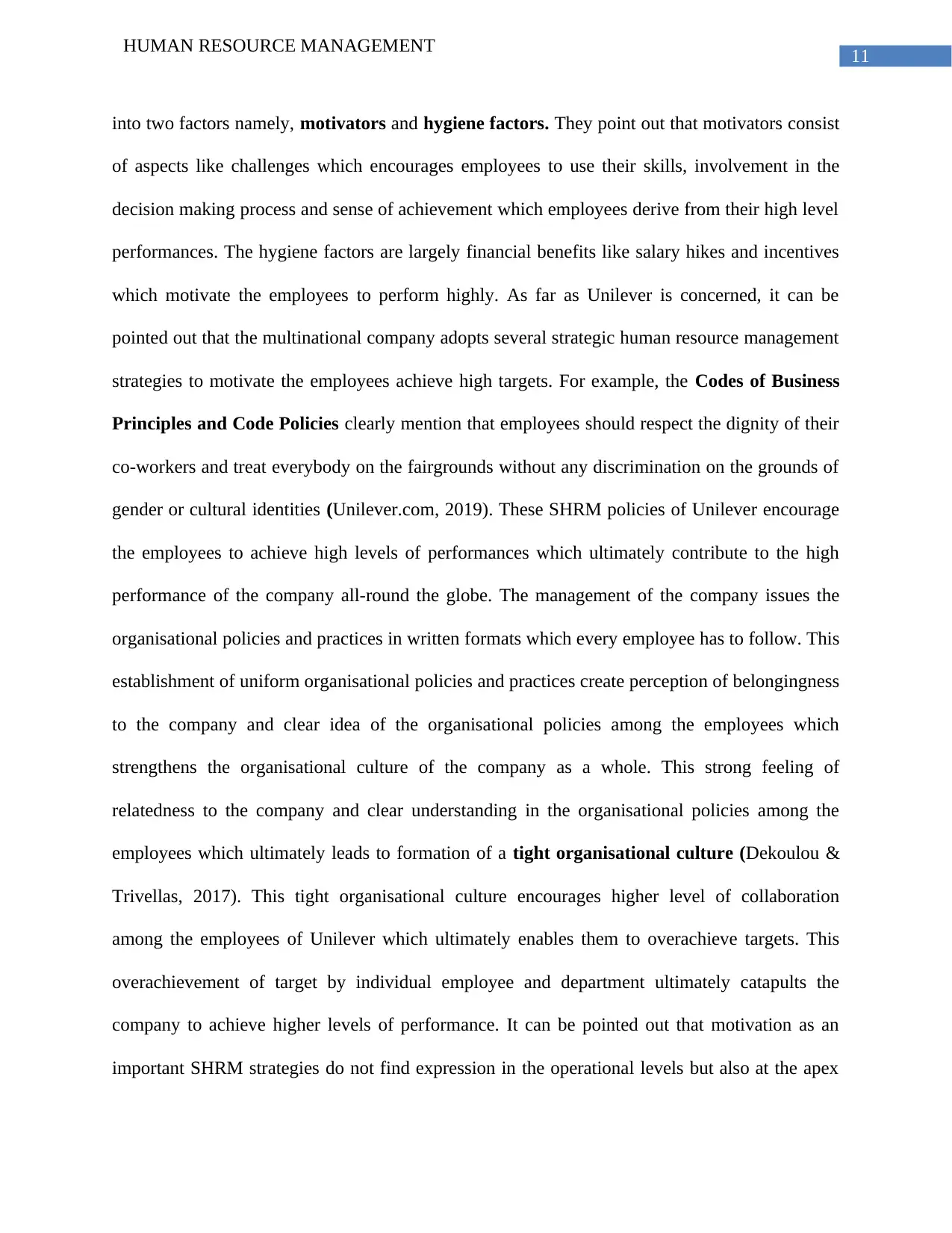
11
HUMAN RESOURCE MANAGEMENT
into two factors namely, motivators and hygiene factors. They point out that motivators consist
of aspects like challenges which encourages employees to use their skills, involvement in the
decision making process and sense of achievement which employees derive from their high level
performances. The hygiene factors are largely financial benefits like salary hikes and incentives
which motivate the employees to perform highly. As far as Unilever is concerned, it can be
pointed out that the multinational company adopts several strategic human resource management
strategies to motivate the employees achieve high targets. For example, the Codes of Business
Principles and Code Policies clearly mention that employees should respect the dignity of their
co-workers and treat everybody on the fairgrounds without any discrimination on the grounds of
gender or cultural identities (Unilever.com, 2019). These SHRM policies of Unilever encourage
the employees to achieve high levels of performances which ultimately contribute to the high
performance of the company all-round the globe. The management of the company issues the
organisational policies and practices in written formats which every employee has to follow. This
establishment of uniform organisational policies and practices create perception of belongingness
to the company and clear idea of the organisational policies among the employees which
strengthens the organisational culture of the company as a whole. This strong feeling of
relatedness to the company and clear understanding in the organisational policies among the
employees which ultimately leads to formation of a tight organisational culture (Dekoulou &
Trivellas, 2017). This tight organisational culture encourages higher level of collaboration
among the employees of Unilever which ultimately enables them to overachieve targets. This
overachievement of target by individual employee and department ultimately catapults the
company to achieve higher levels of performance. It can be pointed out that motivation as an
important SHRM strategies do not find expression in the operational levels but also at the apex
HUMAN RESOURCE MANAGEMENT
into two factors namely, motivators and hygiene factors. They point out that motivators consist
of aspects like challenges which encourages employees to use their skills, involvement in the
decision making process and sense of achievement which employees derive from their high level
performances. The hygiene factors are largely financial benefits like salary hikes and incentives
which motivate the employees to perform highly. As far as Unilever is concerned, it can be
pointed out that the multinational company adopts several strategic human resource management
strategies to motivate the employees achieve high targets. For example, the Codes of Business
Principles and Code Policies clearly mention that employees should respect the dignity of their
co-workers and treat everybody on the fairgrounds without any discrimination on the grounds of
gender or cultural identities (Unilever.com, 2019). These SHRM policies of Unilever encourage
the employees to achieve high levels of performances which ultimately contribute to the high
performance of the company all-round the globe. The management of the company issues the
organisational policies and practices in written formats which every employee has to follow. This
establishment of uniform organisational policies and practices create perception of belongingness
to the company and clear idea of the organisational policies among the employees which
strengthens the organisational culture of the company as a whole. This strong feeling of
relatedness to the company and clear understanding in the organisational policies among the
employees which ultimately leads to formation of a tight organisational culture (Dekoulou &
Trivellas, 2017). This tight organisational culture encourages higher level of collaboration
among the employees of Unilever which ultimately enables them to overachieve targets. This
overachievement of target by individual employee and department ultimately catapults the
company to achieve higher levels of performance. It can be pointed out that motivation as an
important SHRM strategies do not find expression in the operational levels but also at the apex
⊘ This is a preview!⊘
Do you want full access?
Subscribe today to unlock all pages.

Trusted by 1+ million students worldwide
1 out of 21
Related Documents
Your All-in-One AI-Powered Toolkit for Academic Success.
+13062052269
info@desklib.com
Available 24*7 on WhatsApp / Email
![[object Object]](/_next/static/media/star-bottom.7253800d.svg)
Unlock your academic potential
Copyright © 2020–2025 A2Z Services. All Rights Reserved. Developed and managed by ZUCOL.





